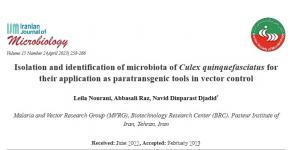
10/08/1402
Isolation and identification of microbiota of Culex quinquefasciatus for their application as paratransgenic tools in vector control
Background and Objectives:Although
the study on the bacteria residing in the mid-gut, salivary gland, and
reproductive organs of insect vectors have drawn appeal to the
host-pathogen interactions, we know comparatively less about microbiota
that naturally exist in different mosquito organs within Iran. Materials and Methods:In
the current investigation, PCR assay by using 16S rRNA gene
amplification and DNA sequencing, in addition to the traditional
culture-based approach utilized for the detection of cultivable
bacterial assemblages in mid-gut and reproductive tracts of Culex quinquefasciatus. Results:The identified bacteria isolated from different tissues of 45 individuals were consisted of Achromobacter, Aeromonas, Arthrobacter, Asaia, Enterobacter, Gluconobacter, Klebsiella, Lysinibacillus, Micrococcus, Psuedomonas and Serratia. The results showed that Proteobacteria was the most prevalent phylum in both genders mid-gut and reproductive tracts, and Asaia was the most common bacteria that originated in adult females and males’ tissues. Conclusion:These outcomes recommend that the discovered microbiome may span through Cx. quinquefasciatus
populations. This data can be utilized to interfere with the
transmission of pathogens and design new strategies for the control of
mosquito-borne diseases. Keywords: Vector-borne diseases, Culex, Polymerase chain reaction, Bacteria
|